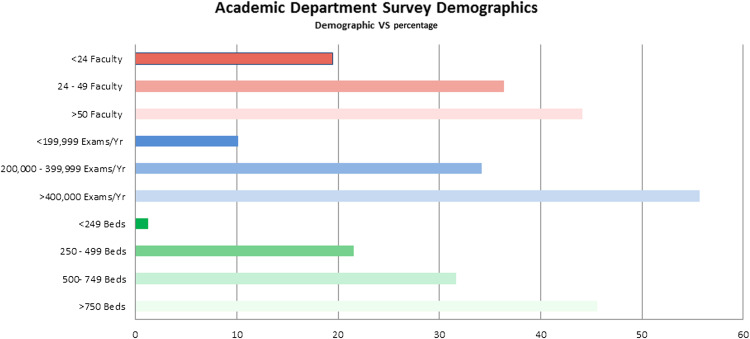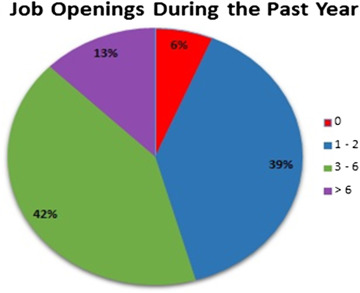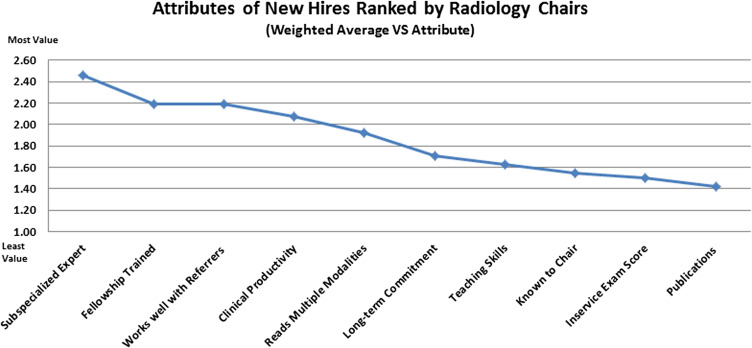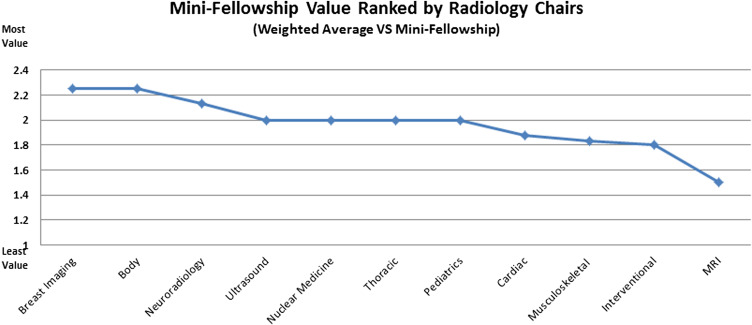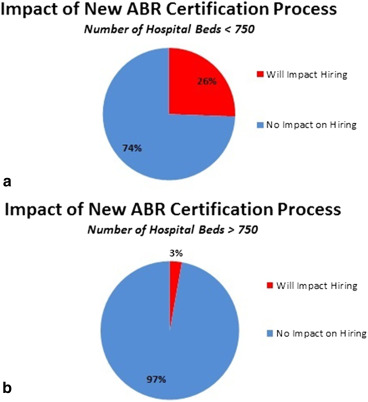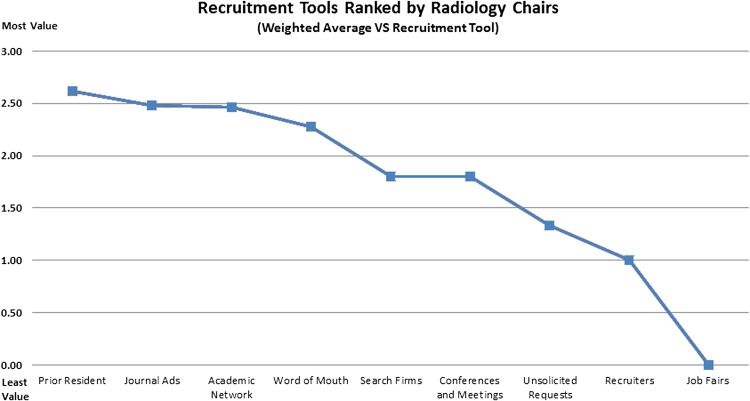Rationale and Objectives
To determine hiring preferences among academic radiology department chairs with emphasis on recent residency and fellowship graduates.
Materials and Methods
With the assistance of the Society of Chairs of Academic Radiology Departments (SCARD), an anonymous survey was distributed to academic radiology department chairs during the time period December 2014–March 2015, with additional reminder emails during the study period. Varied multiple choice questions were designed to gather information regarding program details; qualities most valued in new attending hires; level of difficulty recruiting subspecialty fellowship-trained radiologists; and the effect of the new ABR certification process on hiring practices. Descriptive statistics and analyses are reported.
Results
Surveys were completed by 79 of 184 eligible academic radiology chairs, a response rate of 43%. The most important hiring criteria cited were expertise in subspecialty, fellowship training, and perceived ability to work well with referring physicians. The most popular recruitment tools cited were hiring candidates from a chair’s own program, journal ads, and academic networks. A minority of chairs (16%), primarily those of smaller departments, will not hire new graduates before completing board certification under the new certification structure ( P = .0143).
Conclusions
Expertise in a candidate’s subspecialty was consistently cited as the most important hiring criterion. Changes to the ABR certification process, however, will affect hiring decisions, particularly within smaller academic departments.
The status of the radiology job market is a source of concern for radiology trainees. According to the ACR Commission on Human Resources Workforce Survey, job opportunities for radiologists in 2014 were close in number to those of residents completing diagnostic radiology training programs, with available jobs not necessarily in the subspecialty, geographic area, or type of practice an individual most desires . Furthermore, a recent analysis of the ACR Jobs Board revealed a high competitive index, with nearly two new job seekers for every new job posting .
These concerns are compounded by recent changes to the American Board of Radiology (ABR) certification process. Until recently, it was standard practice for residents to complete ABR certification prior to graduation; however, changes in timing of the ABR diagnostic radiology certifying examination now places the examination 15 months after completion of residency training. Consequently, graduating residents and fellows have expressed concern, with possible good reason. A recent study indicates that a significant minority of private practice groups would not hire individuals who are not board certified, including recent graduates who have not had opportunity to complete the certifying process .
Get Radiology Tree app to read full this article<
Materials and methods
Get Radiology Tree app to read full this article<
Get Radiology Tree app to read full this article<
Get Radiology Tree app to read full this article<
Get Radiology Tree app to read full this article<
Get Radiology Tree app to read full this article<
Results
Get Radiology Tree app to read full this article<
Get Radiology Tree app to read full this article<
Get Radiology Tree app to read full this article<
Get Radiology Tree app to read full this article<
Valued Credentials and Attributes
Get Radiology Tree app to read full this article<
Get Radiology Tree app to read full this article<
Get Radiology Tree app to read full this article<
Get Radiology Tree app to read full this article<
Get Radiology Tree app to read full this article<
Get Radiology Tree app to read full this article<
Get Radiology Tree app to read full this article<
Get Radiology Tree app to read full this article<
Impact of New ABR Certification
Get Radiology Tree app to read full this article<
Get Radiology Tree app to read full this article<
Get Radiology Tree app to read full this article<
Get Radiology Tree app to read full this article<
Recruiting Tools
Get Radiology Tree app to read full this article<
Get Radiology Tree app to read full this article<
Get Radiology Tree app to read full this article<
Discussion
Get Radiology Tree app to read full this article<
Get Radiology Tree app to read full this article<
Get Radiology Tree app to read full this article<
Get Radiology Tree app to read full this article<
Get Radiology Tree app to read full this article<
Get Radiology Tree app to read full this article<
Get Radiology Tree app to read full this article<
Get Radiology Tree app to read full this article<
Get Radiology Tree app to read full this article<
Get Radiology Tree app to read full this article<
Conclusion
Get Radiology Tree app to read full this article<
Acknowledgments
Get Radiology Tree app to read full this article<
Supplementary data
Get Radiology Tree app to read full this article<
Appendix A
Get Radiology Tree app to read full this article<
Get Radiology Tree app to read full this article<
References
1. Bluth E., Truong H., Bansal S.: A 2014 ACR commission on human resources workforce survey. JACR 2014; 11: pp. 948-952.
2. Prabhakar A.M., Rahmi O., Harvey H.B., et. al.: The radiology job market: analysis of the ACR jobs board. JACR 2014; 11: pp. 507-511.
3. Bluth E.I., Muroff L.R., Cernigliaro J.G., et. al.: Forecasting the effect of the change in timing of the ABR diagnostic radiology examinations: results of the ACR survey of practice leaders. JACR 2015; 12: pp. 495-500.
4. Warren L.A., Patel T.Y., Layman M.S., et. al.: The job market of the future: how will the recent board change influence the job market for new graduates?. JACR 2015; 12: pp. 206-207.
5. American Medical Association (AMA). FREIDA Online. Available at: http://www.ama-assn.org/ama/pub/education-careers/graduate-medical-education/freida-online.page . Accessed December 1, 2014.
6. Cain J., Scott D.R., Smith K.: Use of social media by residency program directors for resident selection. Am J Health Syst Pharm 2010; 67: pp. 1635-1639.
7. 2014 Social recruiting survey. Available at: https://www.jobvite.com/wp-content/uploads/2014/10/Jobvite_SocialRecruiting_Survey2014.pdf . Accessed May 10, 2015.
8. Thrall J.H., Meehan M.J., Whelton D.G.: Comparison of productivity and cost of full-time and part-time faculty members in an academic department of radiology. JACR 2006; 3: pp. 335-339.
9. Resident and Fellow Corner: Residents narrow their focus in fourth-year programs. Available at: http://www.rsna.org/NewsDetail.aspx?id=509 . Accessed May 6, 2015.
